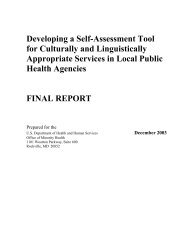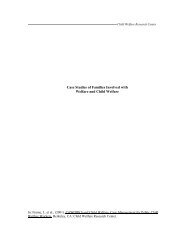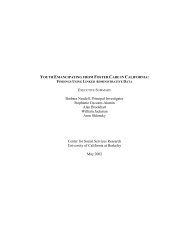Family Assessment in Child Welfare - Center for Social Services ...
Family Assessment in Child Welfare - Center for Social Services ...
Family Assessment in Child Welfare - Center for Social Services ...
Create successful ePaper yourself
Turn your PDF publications into a flip-book with our unique Google optimized e-Paper software.
self-report, observation, and <strong>in</strong>terviews. Each of these methods has its advantages anddisadvantages. A key dist<strong>in</strong>ction is the degree to which the method is <strong>for</strong>malized. Formalmethods, such as self-report questionnaires, tend to have procedures that are clearly outl<strong>in</strong>ed tofacilitate consistently repeated adm<strong>in</strong>istrations. By contrast, <strong>in</strong><strong>for</strong>mal methods such as <strong>in</strong>terviewsmay be less clear <strong>in</strong> their specification and more variable <strong>in</strong> terms of adm<strong>in</strong>istration.<strong>Family</strong> assessment measures also vary <strong>in</strong> terms of the perspective obta<strong>in</strong>ed. Typically,child welfare practitioners will consider the perspectives of multiple <strong>in</strong>dividuals dur<strong>in</strong>g thefamily assessment process, <strong>in</strong>clud<strong>in</strong>g “<strong>in</strong>sider” reports from family members and children as wellas “outsider” reports from school personnel, extended family members, and others that may be<strong>in</strong>volved with the case. Integration of the assessment of multiple reporters with <strong>in</strong>sider andoutsider perspectives is reflected <strong>in</strong> the “multisystem-multimethod” (MS-MM) approach(Cromwell & Peterson, 1983).Self-report questionnaires provide a unique <strong>in</strong>sider view of family life as well as reliablemethods, simplified adm<strong>in</strong>istration and scor<strong>in</strong>g, and a measurable l<strong>in</strong>k between an <strong>in</strong>dividual’sperceptions or attitudes and behaviors. Given these advantages, they are by far the mostcommonly used method <strong>in</strong> research as well as <strong>in</strong> practice. Observation rat<strong>in</strong>g scales provideanother cost-effective method of generat<strong>in</strong>g outsider <strong>in</strong><strong>for</strong>mation regard<strong>in</strong>g family <strong>in</strong>teractionpatterns that can also be evaluated <strong>for</strong> reliability and validity. However, rat<strong>in</strong>g scales can also belimited <strong>in</strong> their usefulness by the competence of the rater and the psychometric quality of thescale. Raters must have a clear understand<strong>in</strong>g of the concepts that are measured and thebehaviors that represent the concepts <strong>in</strong> practice. They must also possess adequate knowledge ofdifferent populations <strong>in</strong> order to place observed behavior on a cont<strong>in</strong>uum, a concern thatadequate tra<strong>in</strong><strong>in</strong>g and cl<strong>in</strong>ical supervision can beg<strong>in</strong> to address. However, as with self-reportmeasures, evidence of the validity and reliability of an observational rat<strong>in</strong>g scale is critical <strong>in</strong> the<strong>in</strong>strument selection process, particularly with regard to specific stages of assessment.<strong>Family</strong> assessment <strong>in</strong>cludes several sequential functions, <strong>in</strong>clud<strong>in</strong>g (1) screen<strong>in</strong>g andgeneral disposition, which typically occur at <strong>in</strong>take; (2) def<strong>in</strong>ition of the problem, which may<strong>in</strong>clude diagnostic assessments (or quantification of problem severity) that occur dur<strong>in</strong>g <strong>in</strong>takeand <strong>in</strong>vestigation procedures; (3) plann<strong>in</strong>g, select<strong>in</strong>g, and match<strong>in</strong>g services with identifiedproblems; and (4) monitor<strong>in</strong>g progress and evaluat<strong>in</strong>g service outcomes (Hawk<strong>in</strong>s, 1979).Validity and reliability are the primary psychometric issues when select<strong>in</strong>g family assessment4
















